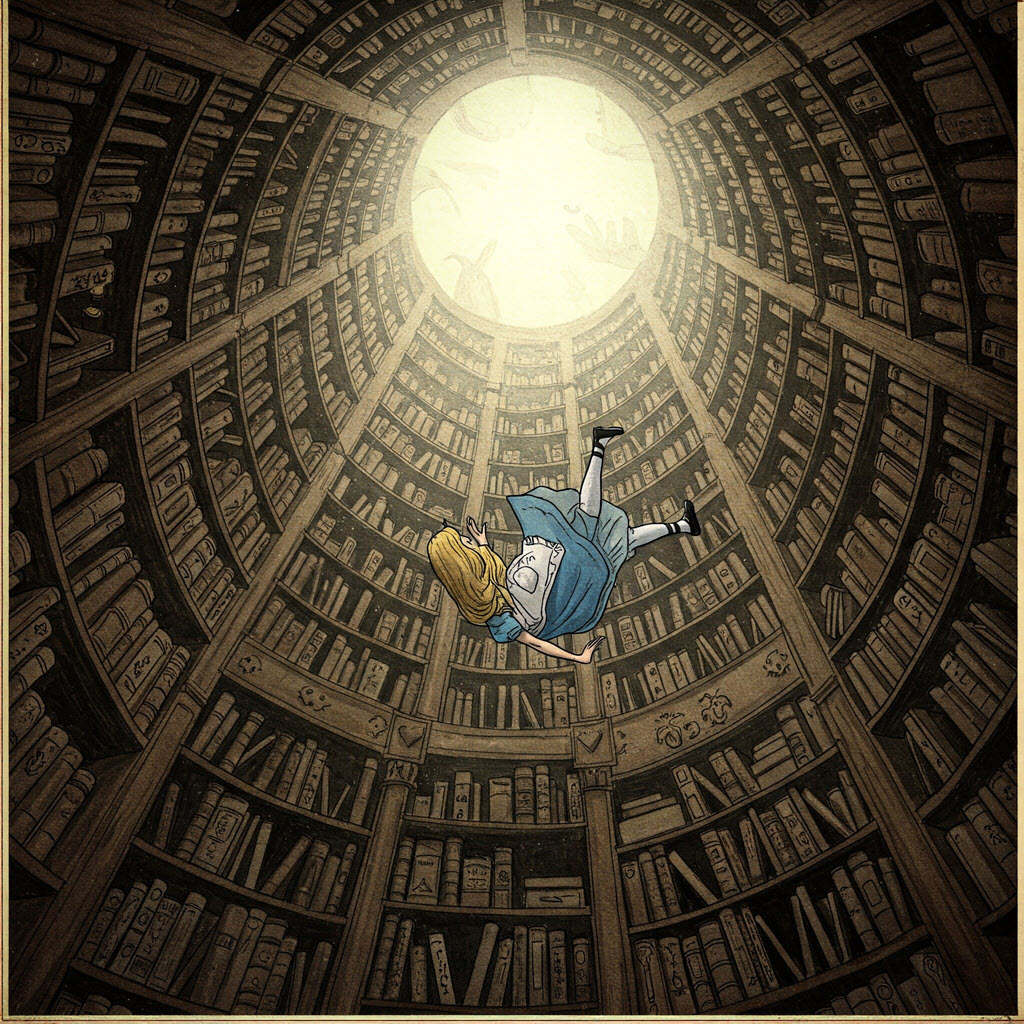
We’re going to dive down a rabbit hole into the world of collecting Lewis Carroll books.
You know the phrase “going down a rabbit hole” comes from Alice In Wonderland, right?
Book collecting has been called “a gentle madness.” Maybe you’ve known a collector – but do you really know what specific insanity drove that person?
There are collectors of first editions. A signed first edition of The Great Gatsby sold for $425,000 last year. It’s a common type of book collecting. There are stores specializing in first editions. A particularly rare first edition of Alice’s Adventures In Wonderland was offered by Christie’s in 2016 for an estimated two to three million dollars. (It failed to meet its reserve and was withdrawn; it has not been on the market since then.)
Some people seek to own every title published by a particular author. Perhaps you assemble a shelf of Stephen King books and decide to make it complete and then you discover the small press and obscure titles that simply must be included and you find yourself tracking down a copy of Hearts In Suspension, a collection of essays about student life published by the University of Maine in 2016, even though you’re not completely sure you want to actually read it.
But we’ve only begun. There are collectors who want to own a copy of every edition of every title by a particular author. I know someone personally who has over four hundred different editions of Philip K. Dick’s 44 novels, carefully assembled over a period of more than forty years.
Okay, yes, it’s me. Don’t judge me, I have far more extreme examples to talk about below before we get to my collection of Snarks.
Some people focus on illustrations and seek all the versions of a book with art from different artists. Random House printed 200 copies of Alice In Wonderland in 1969 with twelve paintings by Salvador Dali, signed by the artist and paired with high quality reproductions of the artwork. The sets are fabulously valuable.
Others focus on translations and foreign publications of well-known books. Vladimir Nabokov was paid five dollars for a Russian translation of Alice In Wonderland while an undergraduate at Cambridge. It was published in very small numbers by a Russian printer exiled to Berlin.
There are collectors who focus on historical significance or limited print runs. There are people recreating childhood libraries or collecting favorite childhood books. There are collections built around particular publishers or focused on beautifully designed editions. A particular era or genre might inspire a collection of books from the Golden Age of Science Fiction, say.
Almost every collector dreams their collection has investment value. Most people eventually come to understand that profit is unlikely and if anything the collection will be a burden on their heirs. A collection is a labor of love.
And a lot of people love Lewis Carroll.
Last year Edward Guiliano published an oversized hardcover book, Lewis Carroll Collections & Collectors. There are two remarkable things about that. (1) The book was published by the Lewis Carroll Society Of North America, so you have to come to grips with the existence of a large and very active group called the “Lewis Carroll Society of North America” (I am a member), which is separate from the even longer-lived British Lewis Carroll Society. (2) The other thing to wrap your head around is that there are so many serious Lewis Carroll collectors that a book can be written about them.
Let’s use Mark Burstein’s collection as an example.
Mark Burstein has been studying and collecting Lewis Carroll for his entire life, following in the footsteps of his father, Sandor, a prolific collector and past president of the Lewis Carroll Society of North America. Mark Burstein has written books about Carroll and made innumerable contributions to books and journals about Carroll. He is a past president and the long-time editor of the Society’s semi-annual newsletter, and he has one of the larger (but hardly the largest) collection of Carroll books and memorabilia.
The Burstein collection is located in a wing of his house in Petaluma, California. This causes me some angst, since I live right up the road but I can’t quite bring myself to knock on doors trying to locate him and beg to go inside and gawk.
There are more than six thousand items in the Burstein Collection, which the Guiliano book describes this way:
“Rare and popular editions of Lewis Carroll’s works, translations, biographies, bibliographies, collections of letters, abridgements, diaries, parodies, comics, pastiches, marginalia, fiction, catalogs, anthologies, academia, hermeneutica, dramas, annotations, interpretations, books about Carroll’s photography and mathematics, Carroll, illustrators, original art, and a few thousand tchotchkes, toys, dolls, and other non-book items.”
The Burstein collection is notable but not the largest Carroll collection, oh my, no. Christ Church Oxford was startled to receive a gift from Jon Lindseth of one of the world’s largest collections in late 2024 – many, many thousands of books, hundreds of signed letters, more than 100 of Carroll’s photographs, and much more. There are spectacular, comprehensive, well organized collections in the hands of institutions and collectors around the world. Yoshiyuki Momma has the largest collection in Japan, including a Japanese translation signed by Alice Liddell Hargreaves, the inspiration for the Alice books – extraordinary and nearly priceless because Hargreaves steadfastly refused to sign Alice books during her lifetime, with very rare exceptions.
But I am particularly drawn to Selwyn Goodacre’s collection because he is a completist like me, seeking to have every edition of the Carroll books, with a particular interest in The Hunting Of The Snark. Goodacre’s “Listing of the Snark” started as a typewritten list of editions of the poem in 1974 and has been steadily expanded since then, until it has become the standard source of bibliographic information reprinted in anniversary and annotated editions of the poem. His most recent publication is Engaging The Snark: A Textual Commentary On The Hunting Of The Snark.
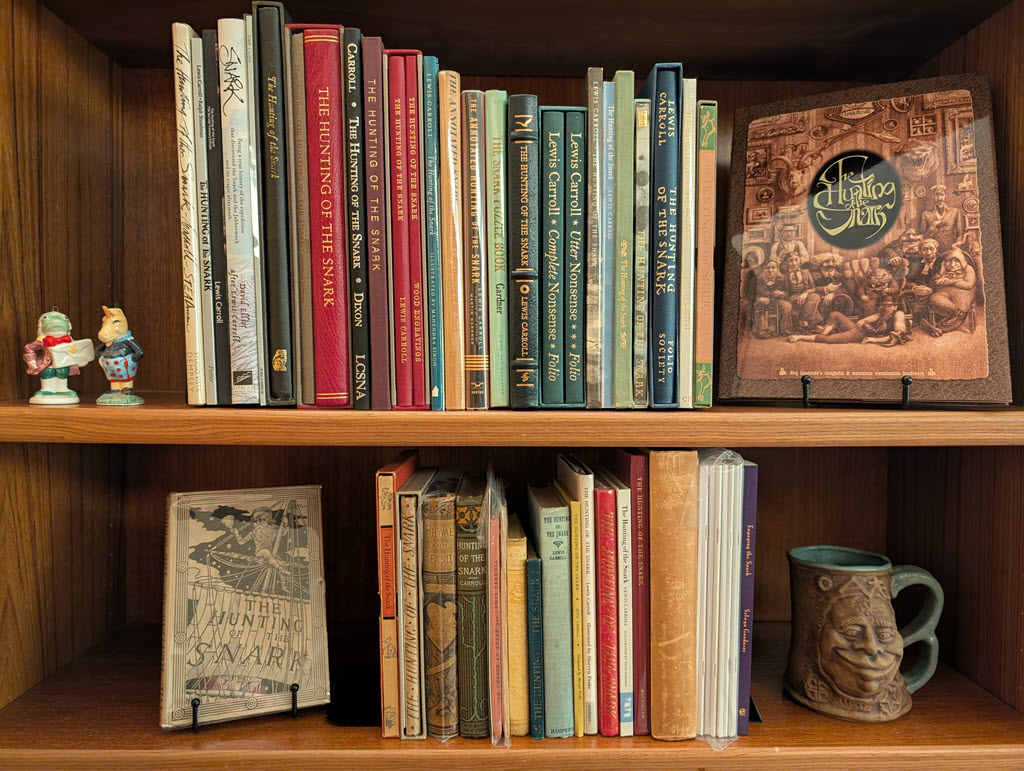
Internet rabbit holes make us feel inadequate. You know the feeling. We take something seriously and study it and devote resources to it – and then a dive into Google reveals that others have been studying harder for longer with more resources than we could have dreamed of.
How can my Snark collection compare? I have forty-five different editions of the poem and a couple of dozen related titles.
But they make me happy.
I have a true first edition from 1876.
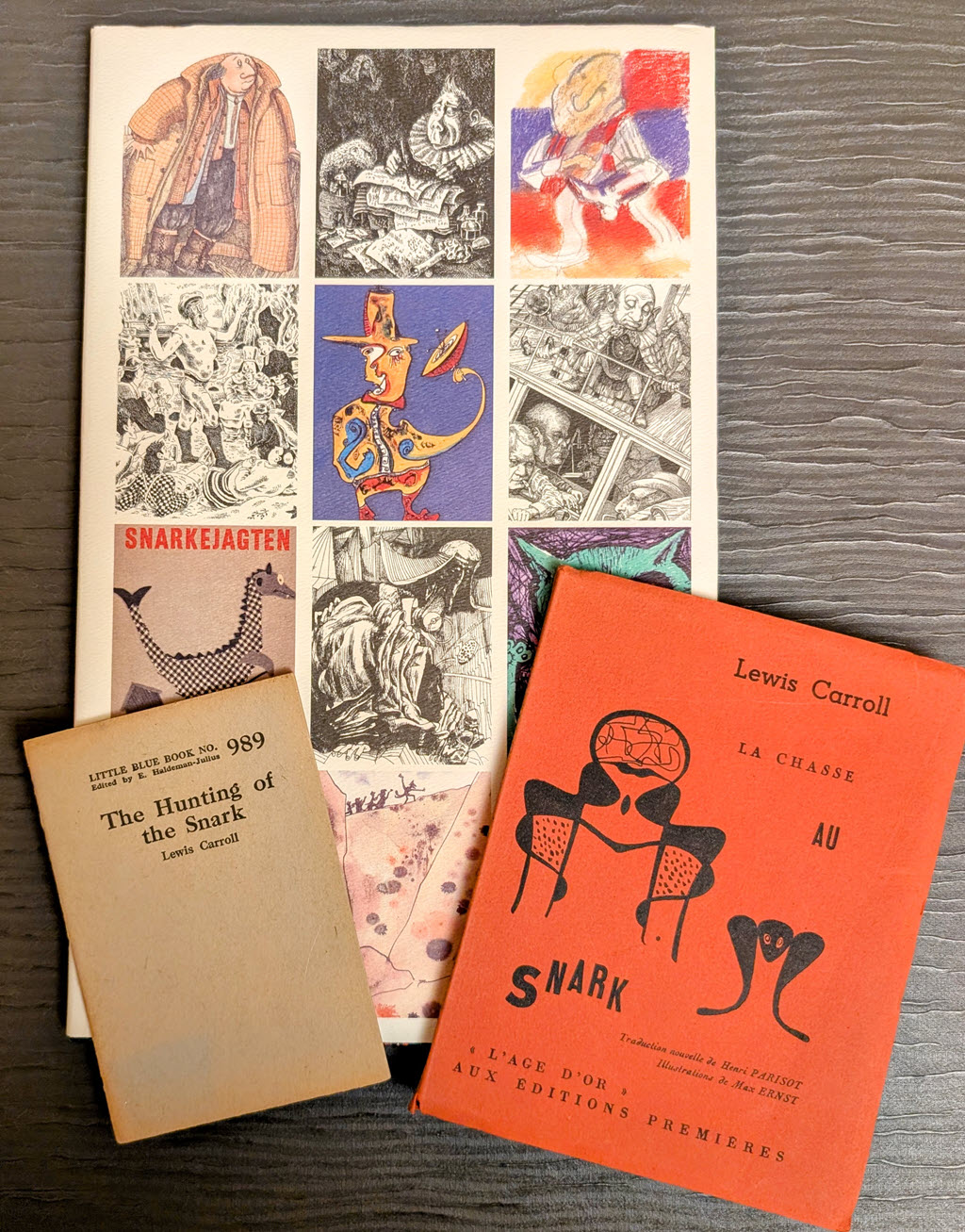
I have a Little Blue Book, one of the strangest releases – a thin pamphlet issued in 1926 on cheap paper and sold for five cents.
I have a numbered limited French paperback from 1950 with illustrations by the artist Max Ernst. The collages are distinctly unappealing, with very little that relates to the poem, more like napkin doodles than fine art, but it’s a very difficult book to find and I’m happy to have spotted it in a French bookseller’s stock.
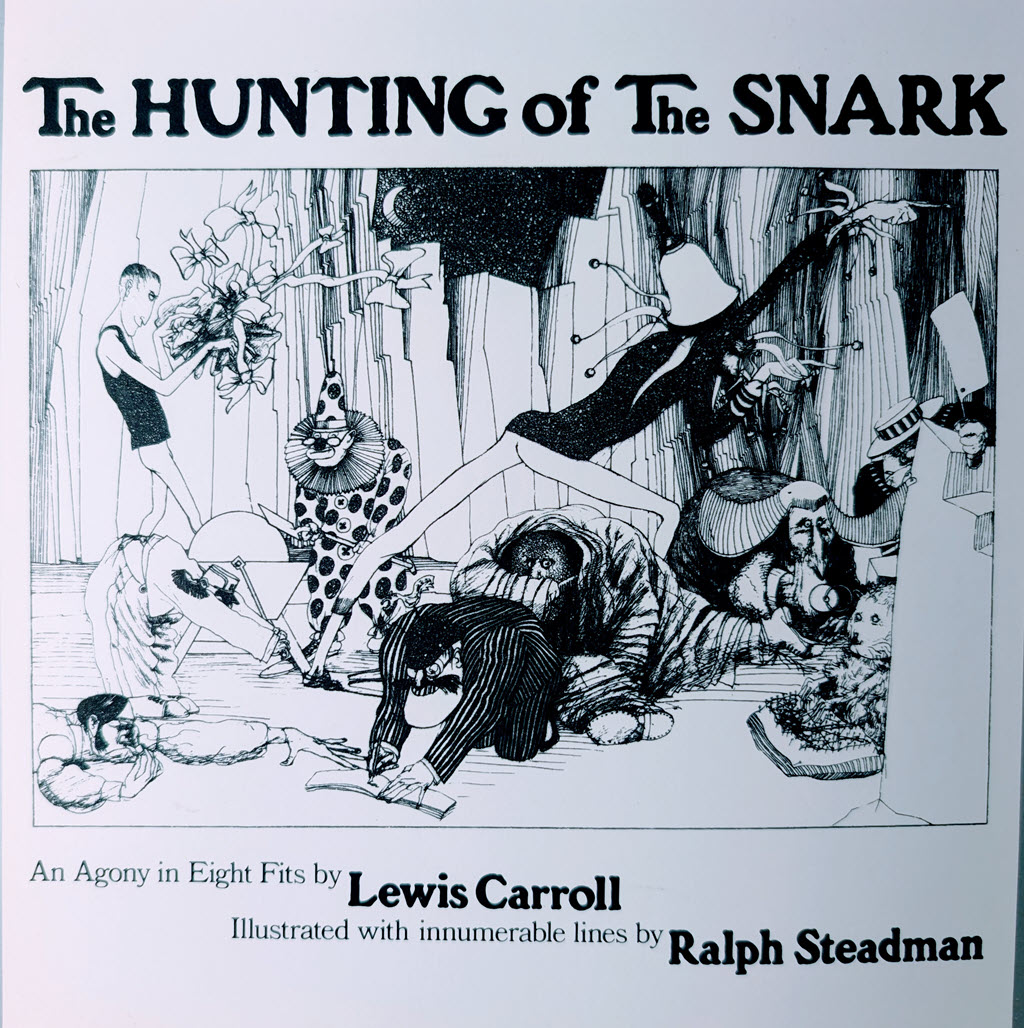
I have the first edition of Snark with illustrations by Ralph Steadman, the artist best known for his work with Hunter Thompson.
There was a limited run of 130 copies of The Hunting Of The Snark in 1993 with the illustrations by Henry Holiday printed from the original wood-engraved blocks for the first time since 1876. It took years of patient hunting to track a copy down.
In 2022 artist Ian Corfe-Stephens contributed new illustrations to a letterpress-printed edition of Snark bound by Ludlow Bookbinder, one of the world’s premier bookbinders in the 21st century. Only 63 copies were numbered and signed. Another difficult title to find.
My collection is small in the world of Carroll collectors but it makes me inordinately happy and proud.
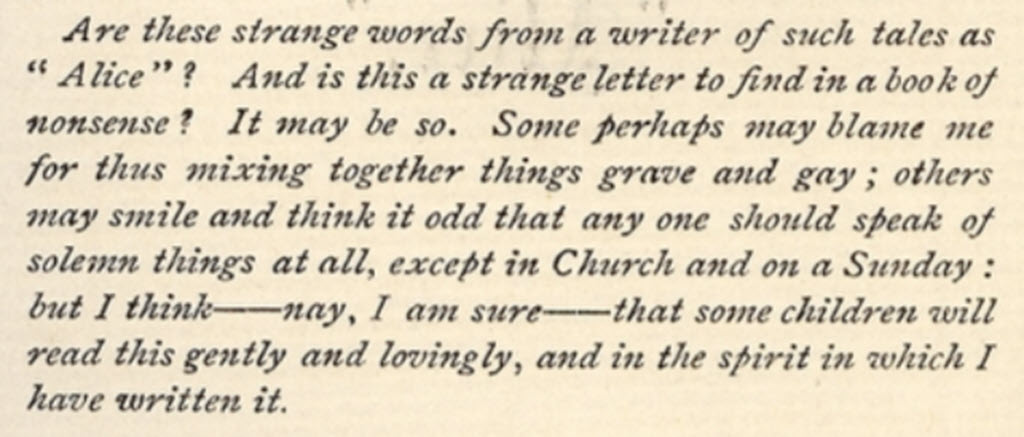
Those are treasures, each and every one. But one of the favorite items in my Lewis Carroll collection – and one of the most valuable – is a single folded piece of flimsy paper titled “An Easter Greeting To Every Child Who Loves Alice.”
Lewis Carroll wrote a loving note to children and tucked a copy loose into the first edition of The Hunting Of The Snark in 1876. We’re out of practice dealing with sincerity in the 21st century – to our jaded eyes it seems sappy and saccharine.
“Do you know that delicious dreamy feeling when one first wakes on a summer morning? And is not that a Mother’s gentle hand that undraws your curtains, and a Mother’s sweet voice that summons you to rise? To rise and forget, in the bright sunlight, the ugly dreams that frightened you so when all was dark – to rise and enjoy another happy day, first kneeling to thank that unseen Friend, who sends you the beautiful sun?”
No? It doesn’t make you feel warm and cuddly? We are perhaps too cynical and modern for our own good.
In any case, I sense that you do not quite share my excitement about owning that little piece of paper.
In an early Carroll bibliography, it was called “the rarest of the Carroll items excepting the first issue of Alice.” More copies have emerged since then but the true first printing of An Easter Greeting is still exceedingly rare.
A loose piece of paper tucked into a children’s book is almost certainly going to be lost. Most copies of that original printing of An Easter Greeting have disappeared.
It was reprinted and later versions were inserted into a couple of other Carroll books in the next decade. Do not underestimate collectors! There are marks to identify the differences between the ten (10!) different versions of this piece of paper. The first edition was privately printed by an Oxford company and has a watermark reading “Towgood Fine.” My copy has the watermark and it has the word “my” typeset in a different font in the fifth line on the third page, one of the markers of a true first edition.
I found a first edition, first printing of Snark that included the first release of An Easter Greeting tucked inside, at a relative discount from a dealer who may have underestimated the market for Lewis Carroll. My heart leapt in a way that only a collector will truly understand. I used to feel that excitement in second-hand bookstores when an old Philip K. Dick paperback would turn up at the back of a shelf, barely noticed. That feeling is hard to come by in the world of the internet when collecting is less about hunting and more about shopping – look for an item, find it, click to buy it, go back to watching television.
The rabbit hole is deep. There are always more Snarks. Like any good collector, I’m still hunting.

